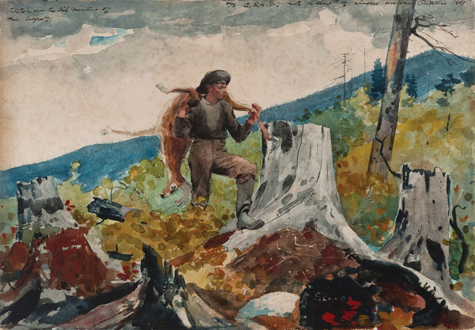
“GUIDE CARRYING A DEER” Watercolor on ivory wove paper, by Winslow Homer, 1891.
|
A hundred years after his death, Winslow Homer is still making waves. Boston native, artistic autodidact, and (eventually) reclusive Scarborough bachelor, Winslow Homer was one of the 19th-century American painters almost singularly associated with nation’s cultural shift from post-Civil War solemnity to sweeping industrial fervor. So integral is he to the American cultural experience that Bill Gates once famously paid over $30 million for one of his late-period pieces. (Is it too late to collect tax on that?)“WINSLOW HOMER AND THE POETICS OF PLACE" at Portland Museum of Art, 7 Congress Square, Portland | through September 6 | 207.775.6148 |
Now featuring 28 of Homer’s works, the Portland Museum of Art has strived to become the
de facto home of the quintessentially American painter, a bond made stronger by their 2006 purchase and ongoing reconstitution of Homer’s late-period encampment in Prouts Neck into a Longfellow-caliber landmark attraction, a project slated for completion in 2012.
Homer, to his credit, bounced around a lot. He lived in Manhattan, Paris, Northern Massachusetts, and coastal England before settling, somewhat dramatically, in the little Scarborough village. The seascapes and wilderness studies he produced during the 27 years he lived here before his death are among the most original — and canonized — works in American history. And although partly responsible for the tourist-friendly mass production of postcard art, these late works are hardly leisurely. Thematically emotional, harsh, dramatic, or wistful, they depicted stirring panoramas of America’s quivering cultural identity. Even, remarkably, in pieces lacking a human subject.
But before oil paintings and watercolors, Homer was an illustrator. Along with his skill as an observer, his relevance grew with the incorporation of visual art in the American periodical, which ultimately gave birth to the genre medium of the art magazine. Inclusions here track Homer studying the marginal fallout of the Civil War, such as the punishment theme found in “The Noon Recess” (an 11-1/8 by 15-7/8 inches wood engraving on wove paper from a summer 1873 issue of Harper’s Weekly) depicting a sandy-haired boy kept inside a schoolhouse during recess while a young woman teacher looks forlornly out the window.
In his mature years, Homer’s best works contain ominous symbols of the imminence of industrialism and its clash with the natural world. The use of a strong, unexpected dash of color, as in Homer’s signatory red ribbon (of cloth in a girl’s hair, of a fish’s blood rippling through water) vividly recalls postwar themes of tragedy and innocence. While several pieces display this technique, equally emphatic is the stunning “Bringing In the Nets” watercolor from 1887 (13-3/4 by 21-1/8 inches), where an ill-lit fisherman stands capably in rippling waters, his limbs engulfed by a complex web of traps, hooks, and buoys. Three enormous houses stand distantly past the opposite shore. Similarly rife is “Guide Carrying a Deer,” an 1891 watercolor (14 by 20-1/16 inches) where a young hunter hefts a slain buck up a hill studded with the stumps of logged trees. In these more so than in his earlier works, Homer’s attention to figures of working peasants and the emerging divisions of class are on prominent display.